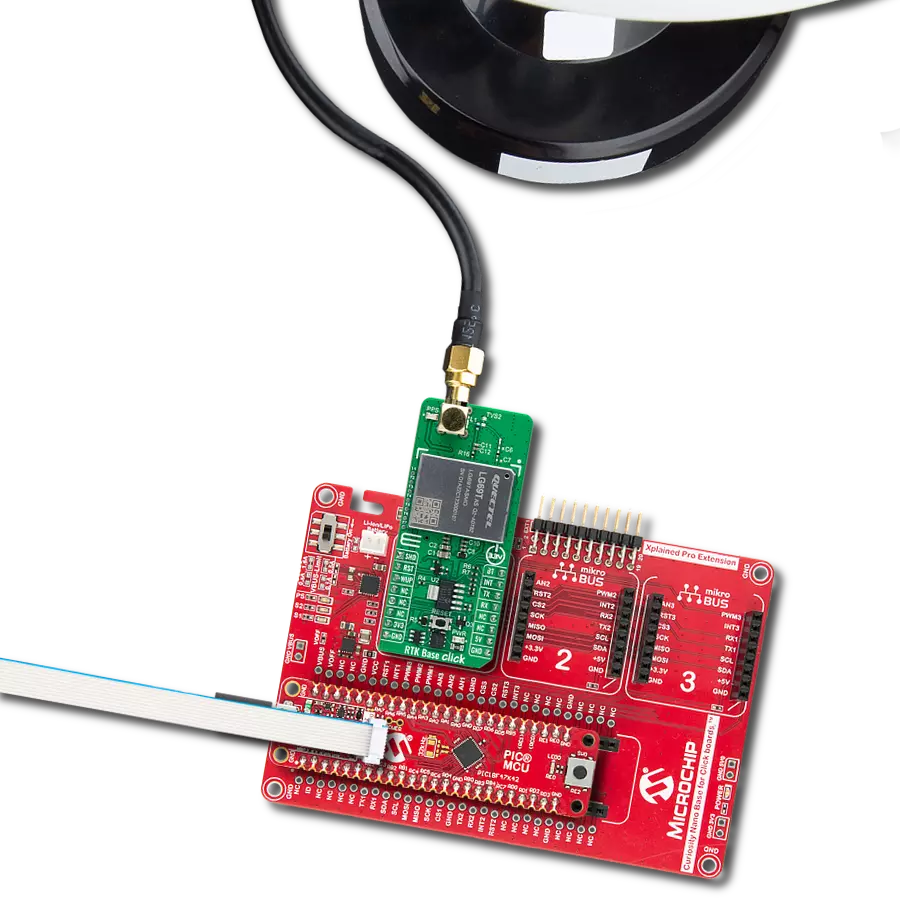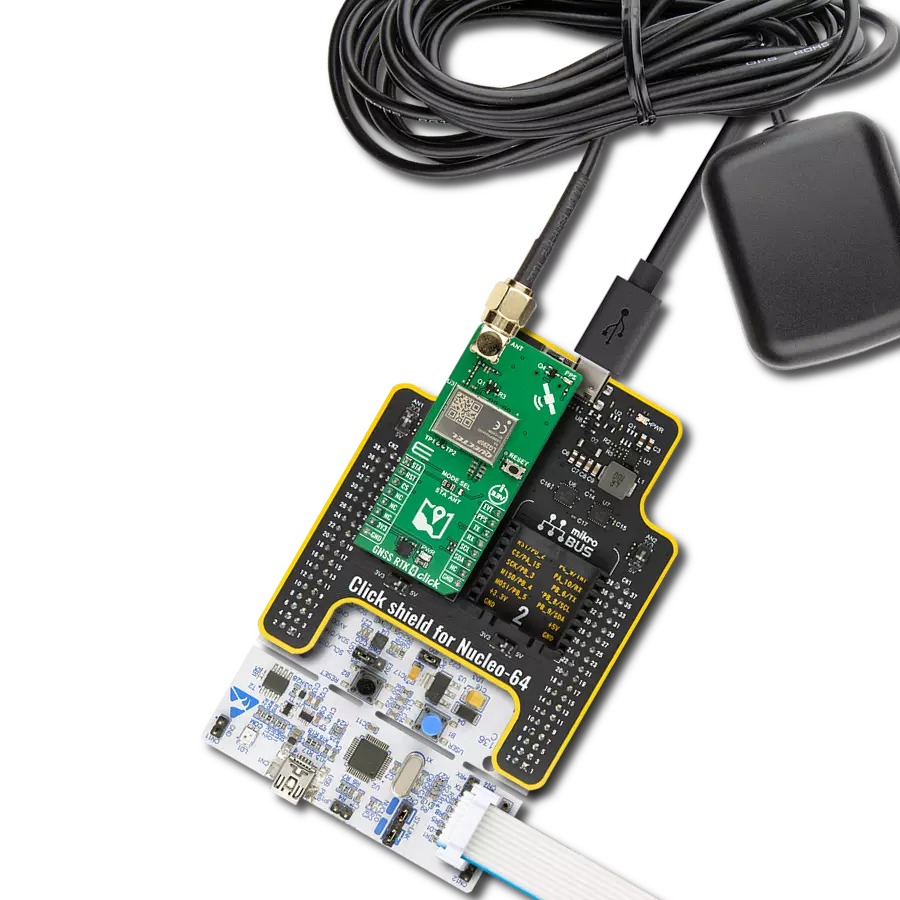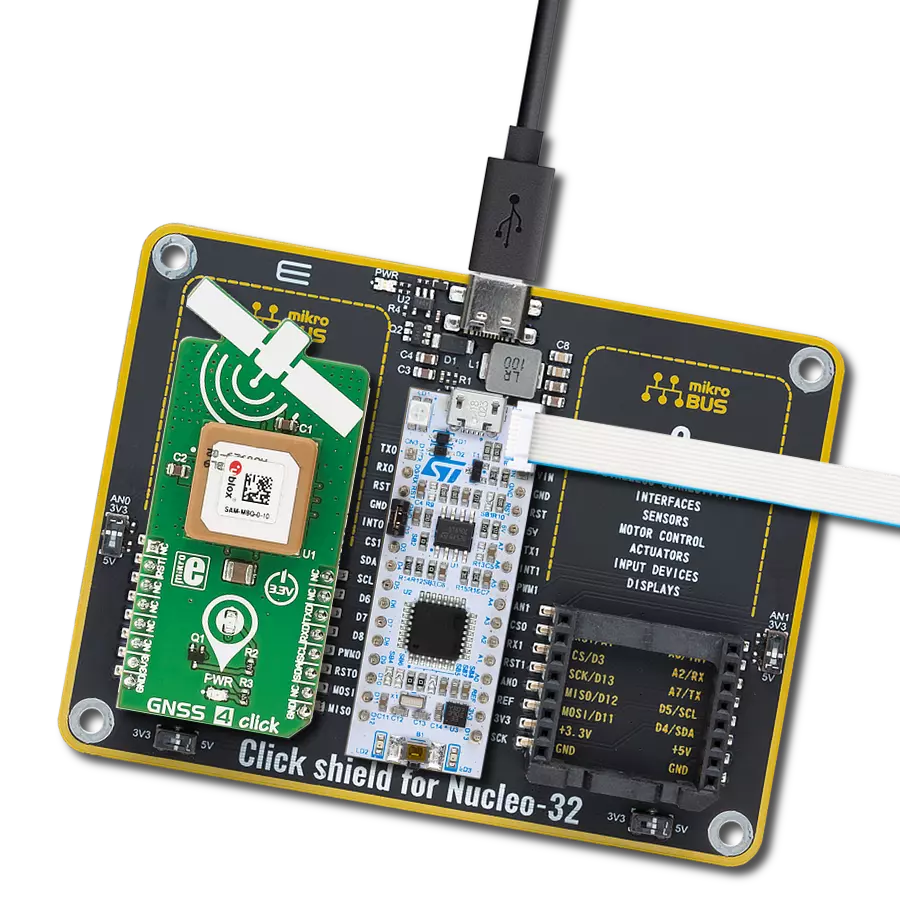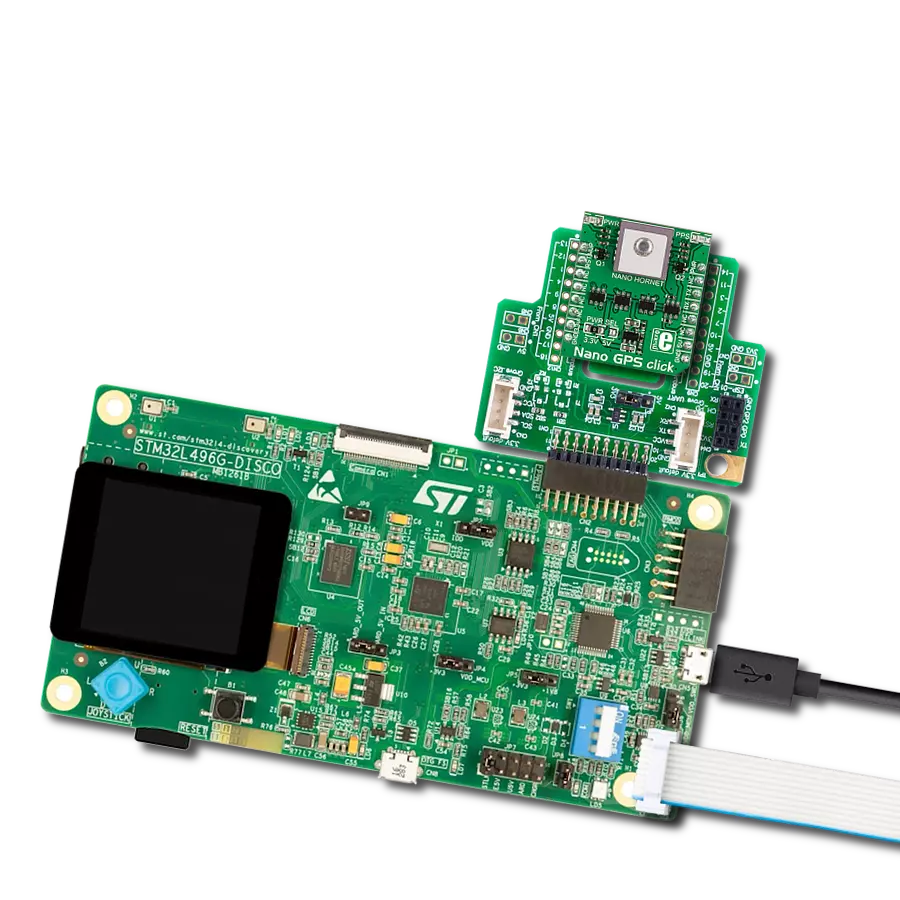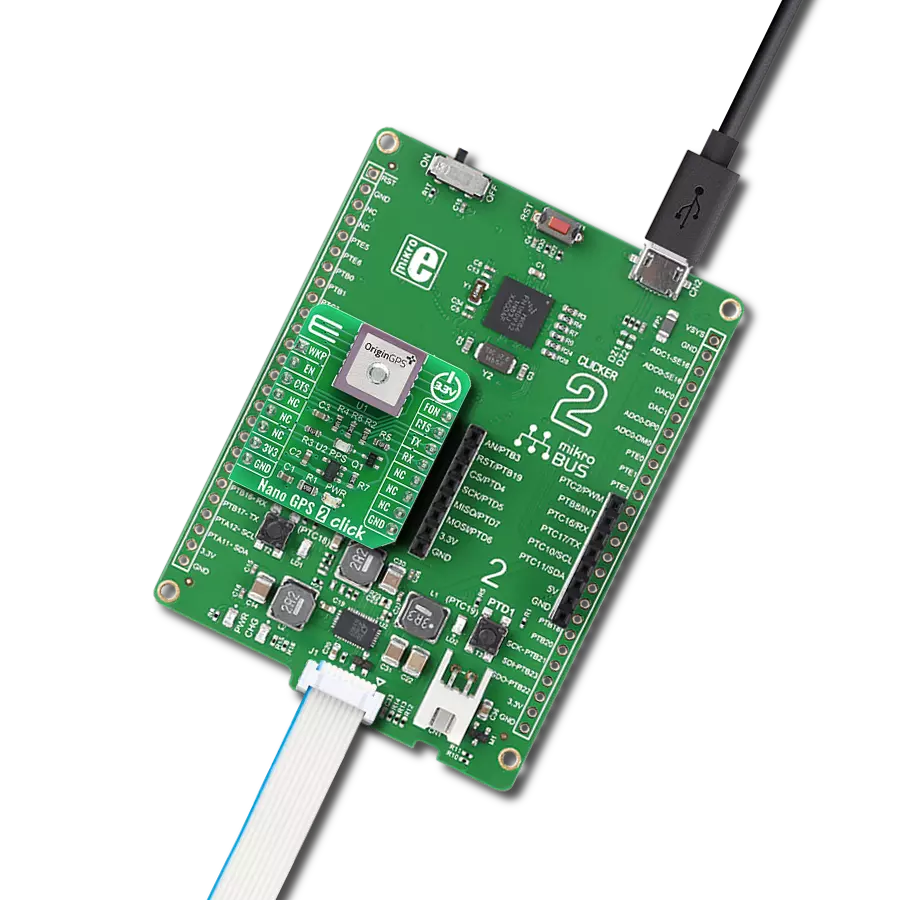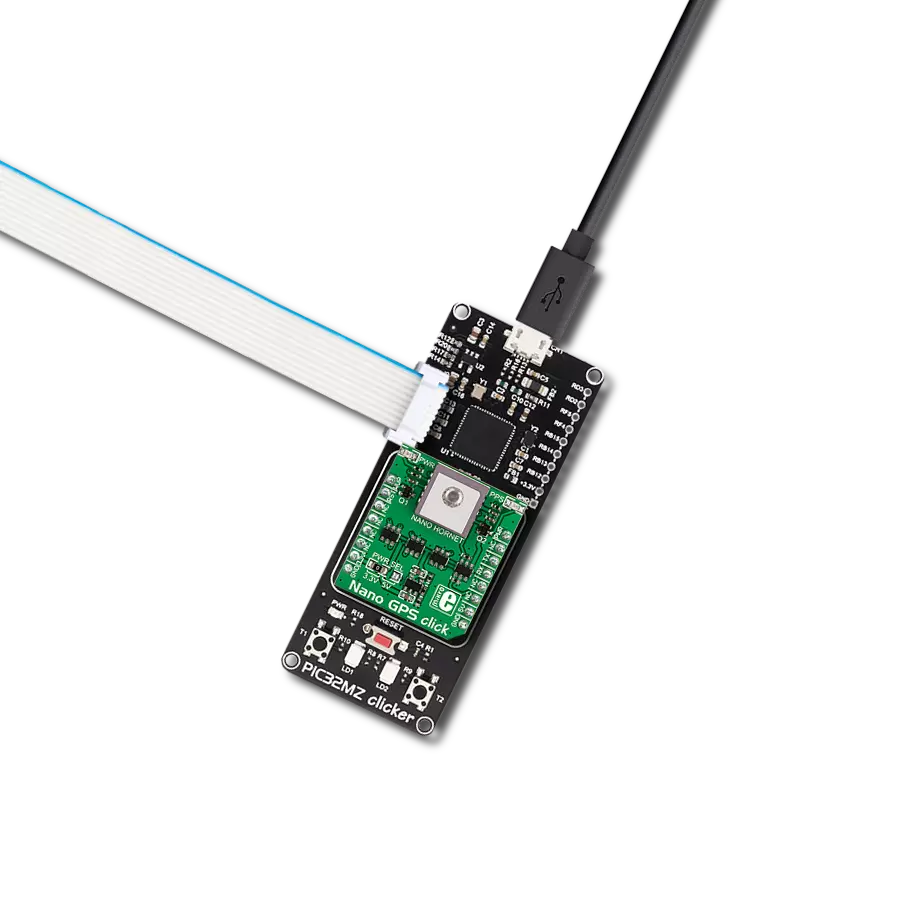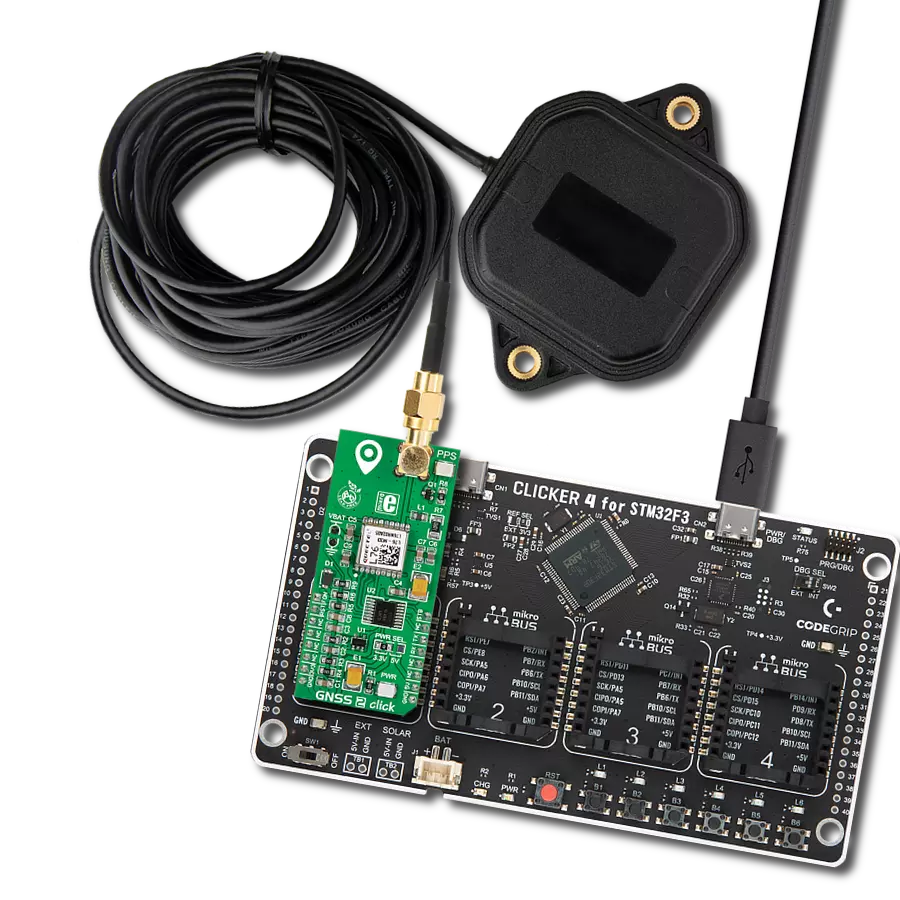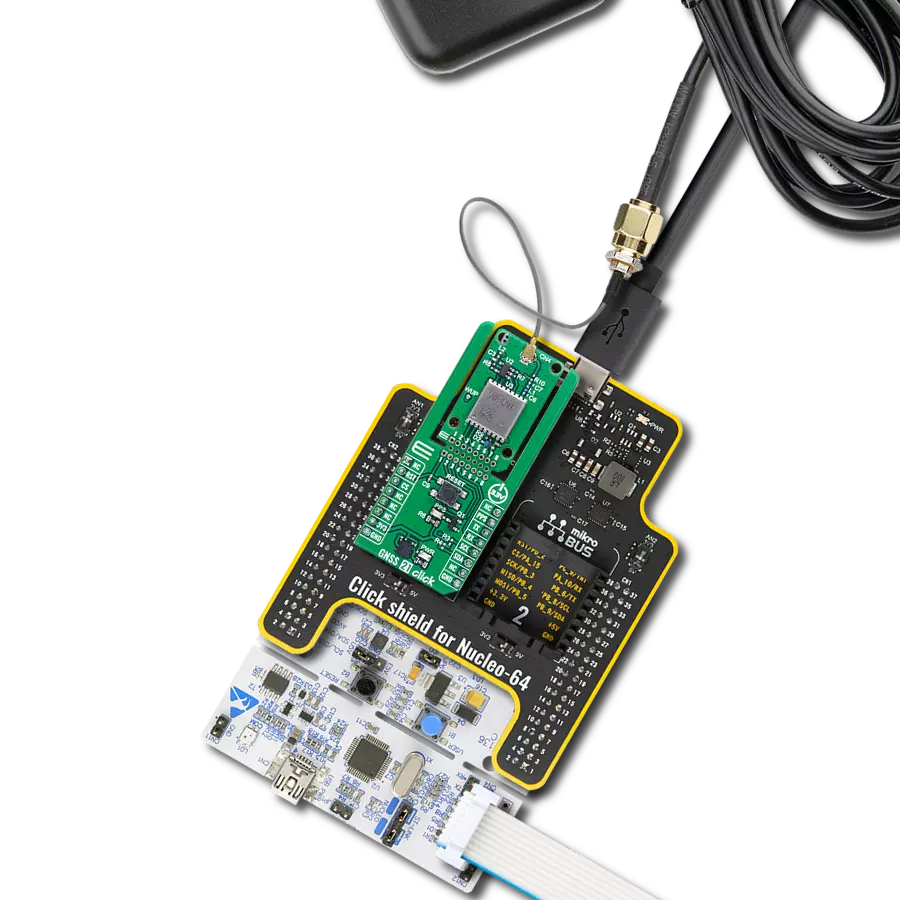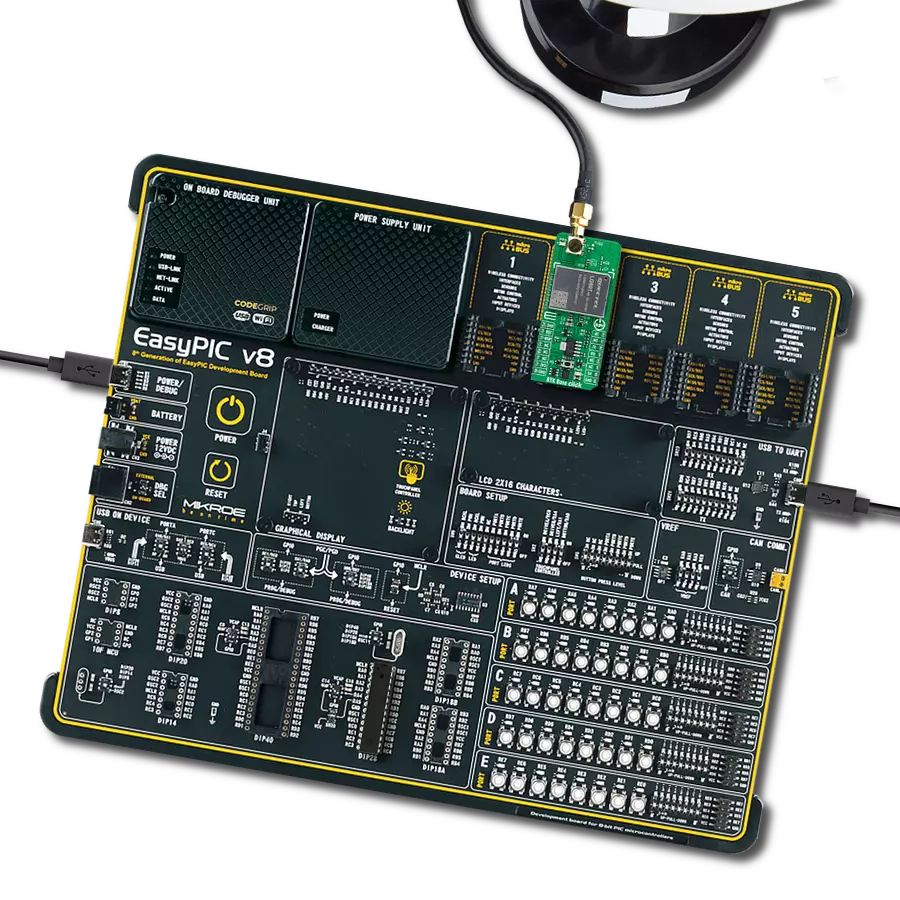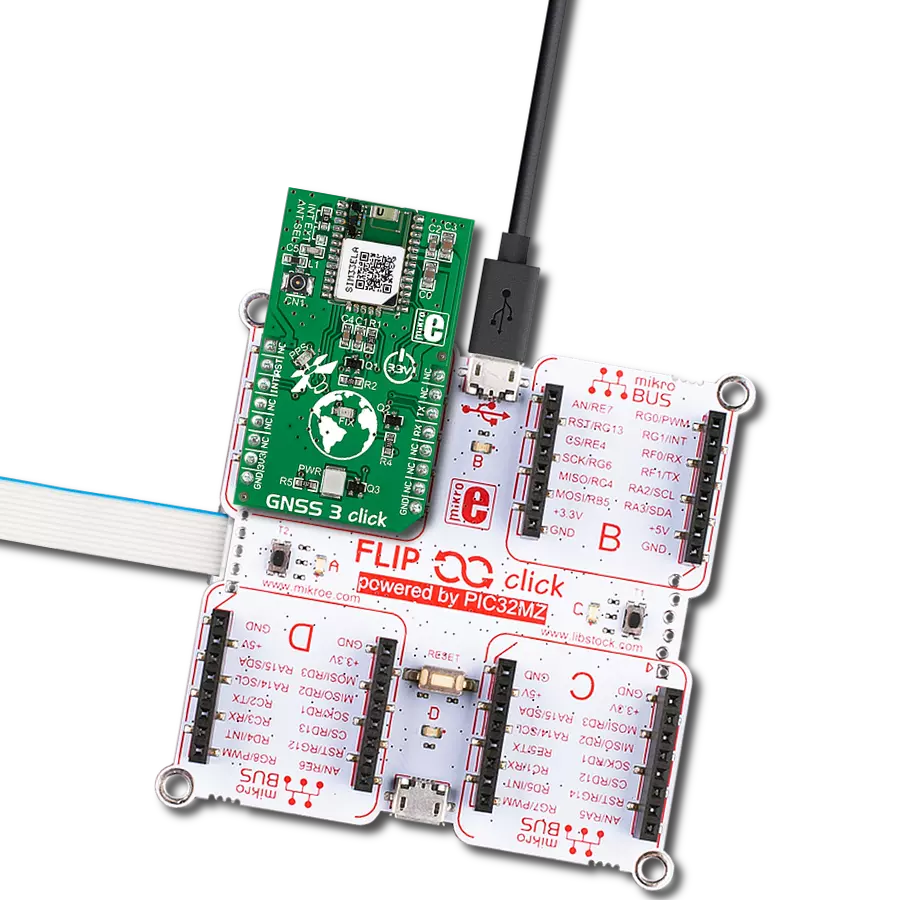Increase the accuracy of GNSS positions using a fixed base station
A
A
Hardware Overview
How does it work?
RTK Base Click is based on the LG69TASMD, a multi-constellation GNSS module featuring a high-performance and high-reliability positioning engine from Quectel Wireless Solutions that improve the positional accuracy of the compatible RTK Rover board. The LG69TASMD has a dual-band supporting up to four concurrent global constellations. It features STMicroelectronics®' fifth-generation positioning receiver platform with 80 tracking, 4 fast acquisition channels, and Quectel's high-performance YG0063AA geodetic antenna. Designed according to the IATF 16949:2016 standard, the LG69TASMD has GPS+BDS+Galileo+QZSS as a default GNSS constellation and an integrated LNA for improved sensitivity. It can receive and track GPS L1 C/A and L5 and Galileo E1 and E5a signals centered at 1575.42MHz and 1176.45MHz, and BeiDou B1I and B2a signals centered at 1561.098MHz and 1176.45MHz. The ability to receive and track BeiDou signals with GPS results in higher coverage, improved reliability, and better accuracy. RTK Base Click communicates with an MCU using the UART interface, with commonly-used
RX and TX pins alongside one data-ready pin (INT), which informs the host MCU to receive data when the buffer transmission is full. It is also equipped with a USB type C connector, which allows the module to be powered and configured by a personal computer (PC) using FT2232D, a compact USB to a serial UART interface device designed to operate efficiently with USB host controllers. The LG69TASMD module provides RTK data output as a base station, supporting static mode alongside fixed mode, set using corresponding commands. It can use its previously-measured antenna positioning coordinates. If this coordinate has the best effect, this method can ensure that the Rover achieves the best accuracy. The LG69TASMD can also self-survey its coordinates in situations without using other methods to measure the base station antenna. The user provides accuracy constraints and the shortest observation time in this mode. In addition to the interface pins, this board uses additional mikroBUS™ pins. A reset signal with the onboard RESET button, routed on the RST pin of the mikroBUS™ socket, performs a reset function of the module, while the
SHD pin routed on the AN pin of the mikroBUS™enables the power supply to the LG69TASMD to be switched ON/OFF. The module can use Boot Download Mode for firmware update via the BT pin routed on the RST pin of the mikroBUS™ socket, alongside a blue LED indicator marked as PPS for time pulse signal information and indication. The module enters Normal operating mode by keeping the BT pin on a low logic state during the Startup sequence. Otherwise, the module enters Boot Download Mode when the pin is high during Startup. A specific addition to this Click board™ is several testpoints that enable additional module features. This Click board™ can operate with both 3.3V and 5V MCUs. As its main power supply, the LG69TASMD uses 3.3V obtained from the MCP1826 LDO; additional backup power can be provided using a coin-shaped battery. The board must perform appropriate logic voltage level conversion before using MCUs with different logic levels. However, the Click board™ comes equipped with a library containing functions and example code that can be used as a reference for further development.
Features overview
Development board
PIC18F47K42 Curiosity Nano evaluation kit is a cutting-edge hardware platform designed to evaluate the PIC18F47K42 microcontroller (MCU). Central to its design is the inclusion of the powerful PIC18F47K42 microcontroller (MCU), offering advanced functionalities and robust performance. Key features of this evaluation kit include a yellow user LED and a responsive mechanical user switch
providing seamless interaction and testing. The provision for a 32.768kHz crystal footprint ensures precision timing capabilities. With an onboard debugger boasting a green power and status LED, programming and debugging become intuitive and efficient. Further enhancing its utility is the Virtual serial port (CDC) and a debug GPIO channel (DGI GPIO), offering extensive connectivity options.
Powered via USB, this kit boasts an adjustable target voltage feature facilitated by the MIC5353 LDO regulator, ensuring stable operation with an output voltage ranging from 2.3V to 5.1V (limited by USB input voltage), with a maximum output current of 500mA, subject to ambient temperature and voltage constraints.
Microcontroller Overview
MCU Card / MCU
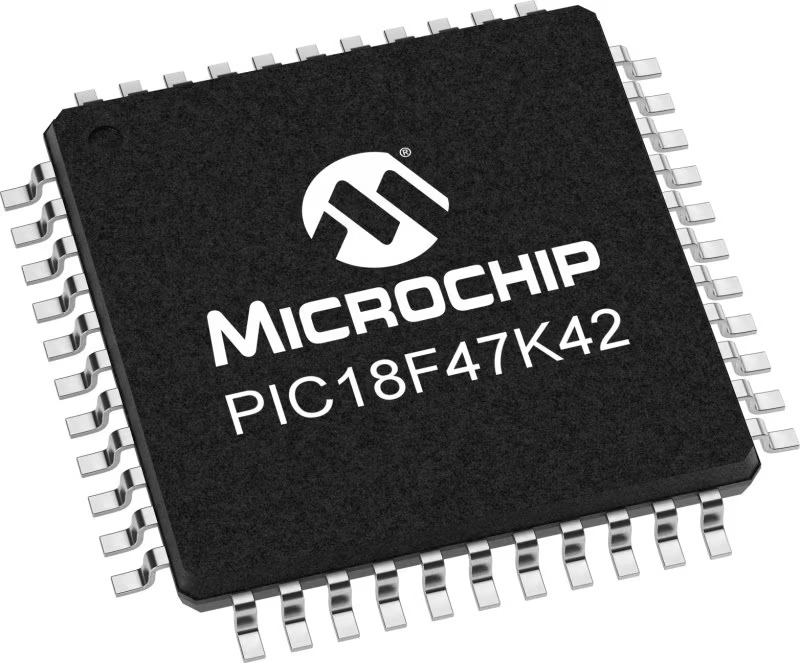
Architecture
PIC
MCU Memory (KB)
128
Silicon Vendor
Microchip
Pin count
40
RAM (Bytes)
8192
You complete me!
Accessories
Curiosity Nano Base for Click boards is a versatile hardware extension platform created to streamline the integration between Curiosity Nano kits and extension boards, tailored explicitly for the mikroBUS™-standardized Click boards and Xplained Pro extension boards. This innovative base board (shield) offers seamless connectivity and expansion possibilities, simplifying experimentation and development. Key features include USB power compatibility from the Curiosity Nano kit, alongside an alternative external power input option for enhanced flexibility. The onboard Li-Ion/LiPo charger and management circuit ensure smooth operation for battery-powered applications, simplifying usage and management. Moreover, the base incorporates a fixed 3.3V PSU dedicated to target and mikroBUS™ power rails, alongside a fixed 5.0V boost converter catering to 5V power rails of mikroBUS™ sockets, providing stable power delivery for various connected devices.
Used MCU Pins
mikroBUS™ mapper
Take a closer look
Click board™ Schematic

Step by step
Project assembly
Software Support
Library Description
This library contains API for RTK Base Click driver.
Key functions:
rtkbase_generic_readThis function reads a desired number of data bytes by using UART serial interface.rtkbase_rx_bytes_availableThis function returns the number of bytes available in the RX ring buffer.rtkbase_calculate_crc24This function calculates and returns the CRC 24-bit of RTCM3 packet input. The CRC across the whole packet should sum to zero (remainder).
Open Source
Code example
The complete application code and a ready-to-use project are available through the NECTO Studio Package Manager for direct installation in the NECTO Studio. The application code can also be found on the MIKROE GitHub account.
/*!
* @file main.c
* @brief RTK Base Click Example.
*
* # Description
* This example demonstrates the use of RTK Base Click by reading and displaying the RTCM3 messages.
*
* The demo application is composed of two sections :
*
* ## Application Init
* Initializes the driver and logger.
*
* ## Application Task
* Reads and parses the RTCM3 messages received from the module, and displays them on the USB UART.
*
* ## Additional Function
* - static void rtkbase_clear_app_buf ( void )
* - static err_t rtkbase_process_rtcm3 ( rtkbase_t *ctx )
*
* @note
* The Click board comes with the default baud rate of 460800, but the baud rate is set to 115200
* in the example due to code portability and speed limitations of some MCUs. So in order to run
* the example you will need to adjust the baud rate using Quectel QGNSS evaluation software.
*
* @author Stefan Filipovic
*
*/
#include "board.h"
#include "log.h"
#include "rtkbase.h"
#define PROCESS_BUFFER_SIZE 300
static rtkbase_t rtkbase;
static log_t logger;
static char app_buf[ PROCESS_BUFFER_SIZE ] = { 0 };
static uint16_t app_buf_len = 0;
/**
* @brief RTK Base clearing application buffer.
* @details This function clears memory of application buffer and reset its length.
* @return None.
* @note None.
*/
static void rtkbase_clear_app_buf ( void );
/**
* @brief RTK Base process rtcm3 function.
* @details This function reads and processes the RTCM3 messages and displays them on the USB UART.
* @param[in] ctx : Click context object.
* See #rtkbase_t object definition for detailed explanation.
* @return @li @c 0 - Successfully read RTCM3 message.
* @li @c -1 - Read error.
* See #err_t definition for detailed explanation.
* @note None.
*/
static err_t rtkbase_process_rtcm3 ( rtkbase_t *ctx );
void application_init ( void )
{
log_cfg_t log_cfg; /**< Logger config object. */
rtkbase_cfg_t rtkbase_cfg; /**< Click config object. */
/**
* Logger initialization.
* Default baud rate: 115200
* Default log level: LOG_LEVEL_DEBUG
* @note If USB_UART_RX and USB_UART_TX
* are defined as HAL_PIN_NC, you will
* need to define them manually for log to work.
* See @b LOG_MAP_USB_UART macro definition for detailed explanation.
*/
LOG_MAP_USB_UART( log_cfg );
log_init( &logger, &log_cfg );
log_info( &logger, " Application Init " );
// Click initialization.
rtkbase_cfg_setup( &rtkbase_cfg );
RTKBASE_MAP_MIKROBUS( rtkbase_cfg, MIKROBUS_1 );
if ( UART_ERROR == rtkbase_init( &rtkbase, &rtkbase_cfg ) )
{
log_error( &logger, " Communication init." );
for ( ; ; );
}
log_info( &logger, " Application Task " );
}
void application_task ( void )
{
rtkbase_process_rtcm3 ( &rtkbase );
rtkbase_clear_app_buf( );
}
int main ( void )
{
/* Do not remove this line or clock might not be set correctly. */
#ifdef PREINIT_SUPPORTED
preinit();
#endif
application_init( );
for ( ; ; )
{
application_task( );
}
return 0;
}
static void rtkbase_clear_app_buf ( void )
{
memset( app_buf, 0, app_buf_len );
app_buf_len = 0;
}
static err_t rtkbase_process_rtcm3 ( rtkbase_t *ctx )
{
#define RTKBASE_HEADER_0 0xD3
#define RTKBASE_HEADER_1 0x00
for ( ; ; ) // loop until a header byte 0 is read
{
while ( rtkbase_rx_bytes_available ( ctx ) < 1 );
if ( 1 == rtkbase_generic_read( ctx, app_buf, 1 ) )
{
if ( RTKBASE_HEADER_0 == app_buf[ 0 ] )
{
break;
}
}
}
// wait until a header byte 1 and packet size bytes are available for read
while ( rtkbase_rx_bytes_available ( ctx ) < 2 );
if ( 2 != rtkbase_generic_read( ctx, &app_buf[ 1 ], 2 ) )
{
return RTKBASE_ERROR;
}
if ( RTKBASE_HEADER_1 != ( app_buf[ 1 ] & 0xFC ) )
{
return RTKBASE_ERROR;
}
app_buf_len = ( ( uint16_t ) ( app_buf[ 1 ] & 0x03 ) << 8 ) + app_buf[ 2 ] + 6; // Header + size + payload bytes + CRC bytes
// wait until payload and CRC bytes are available for read
while ( rtkbase_rx_bytes_available ( ctx ) < ( app_buf_len - 3 ) );
if ( ( app_buf_len - 3 ) != rtkbase_generic_read( ctx, &app_buf[ 3 ], ( app_buf_len - 3 ) ) )
{
return RTKBASE_ERROR;
}
// The CRC across the whole packet should sum to zero (remainder)
if ( 0 == rtkbase_calculate_crc24( app_buf, app_buf_len ) )
{
uint16_t rtcm3_msg_type = ( ( uint16_t ) app_buf[ 3 ] << 4 ) | ( ( app_buf[ 4 ] >> 4 ) & 0x0F ); // 12-bit message type
log_printf ( &logger, "\r\n\n RTCM3 -> Type: %u; Size: %u;\r\n", rtcm3_msg_type, app_buf_len );
for ( int32_t cnt = 0; cnt < app_buf_len; cnt++ )
{
log_printf( &logger, " %.2X", ( uint16_t ) app_buf[ cnt ] );
if ( ( cnt % 16 ) == 15 )
{
log_printf( &logger, "\r\n" );
}
}
return RTKBASE_OK;
}
return RTKBASE_ERROR;
}
// ------------------------------------------------------------------------ END
Additional Support
Resources
Category:GPS/GNSS
